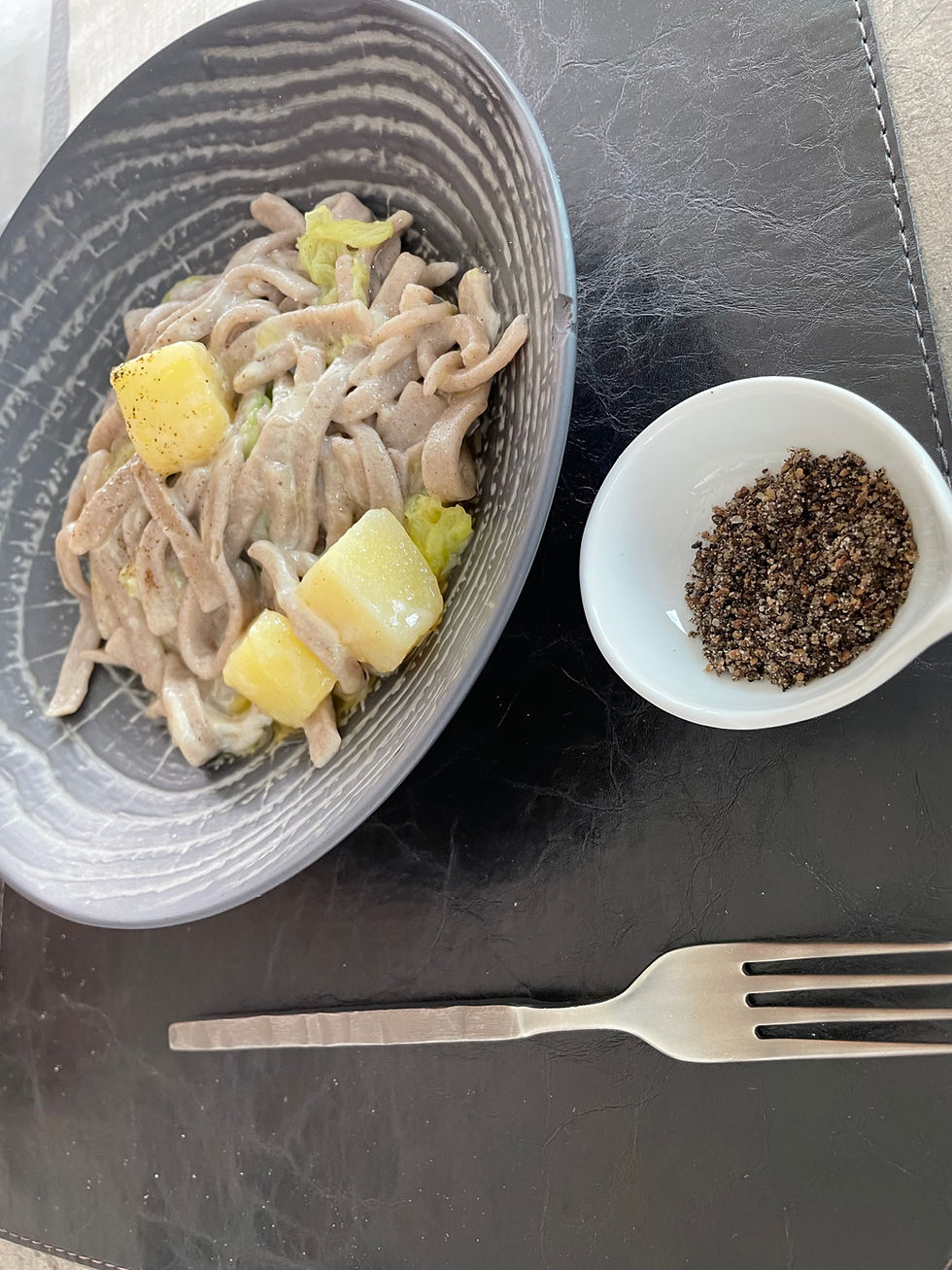2. Pizzoccheri – Nonna Maria's Cucina Alpina
- Reiko Okazaki
- Aug 5, 2024
- 4 min read

One of the reasons why I feel an affinity toward Italian food is the similarity to that of my native Japan, in that we traditionally prepare seasonal ingredients in a simple manner, with attention to produce and provenance. Geographically, both countries are long north to south, resulting in vast regional diversity in climate and food, with islands and peninsulas blessed by the bounty of the mountains and the sea.
Japan is even more mountainous than Italy, and hardy buckwheat (which is a grass seed, not a type of wheat), with its short growing season, is cultivated all over the country. With varying amounts of added wheat flour (sometimes none) to bind the dough together, it is made into Soba noodles. Soba can be served warm or cold, with a clear broth based on seafood (such as bonito) and soy sauce, plus add-ons ranging from grilled duck to vegetable tempura. Aside from the occasional rich topping, it is generally considered a lean food.
Not so in Valtellina. Pizzoccheri is thicker, as in both the pasta themselves, and also the cheese and butter sauce. Although it can sometimes be found on the menu at restaurants outside Valtellina (I have had it at South Melbourne’s Park Street Pasta & Wine), it is invariably a heart-friendly version, Pizzoccheri ‘lite’.
In the motherland, the contents are quite literally swimming in melted butter.
In the motherland, the contents are quite literally swimming in melted butter– comfort food at its finest. It gives a stick-to-your-ribs, warming sensation, perhaps best appreciated after a day of skiing on the slopes. The calories may frighten some, but in moderation (as with everything), this dish is a nourishing marriage of nutrient-dense whole foods. Butter, after all, contains essential fatty acids, vitamins, antioxidants and minerals.
Partly due to the popularity of alternative grains, boxes of dry Pizzoccheri are available at some specialty delis in the inner suburbs of Melbourne, but the pasta tends to be relatively smooth, with a low ratio of finely milled buckwheat in relation to the wheat flour. The shape resembles short tagliatelle.
With coarse buckwheat flour from Valtellina, Alberto makes Pizzoccheri pasta that is bulkier both in width and thickness. The process does not even require a pasta machine, as it is enough to roll out the dough and slice through with a knife. His family always skipped this step, as fresh Pizzoccheri are available to purchase at delis in Valtellina.

In terms of toppings, the standard additions are cubed potatoes and verza. Verza means savoy cabbage, but here in Australia we have substituted brussels sprouts, Tuscan kale and silverbeet, depending on the season. Green beans are also a good match, although technically this constitutes a separate dish called “Taroz”.
As for the sauce, part of the secret is the starch released from the ingredients– yes, indeed this is a one-pot wonder in which the pasta and potatoes thicken the water and seemingly alleviate your dishwashing– but what truly enriches the dish (thereby sticking to your bowls, requiring soaking and scrubbing in the end) are the local dairy products. A visit to the town of Teglio informs us that this alpine dish dates back to at least the 18th century.

Turning back to Pizzocheri’s Japanese counterpart, the beauty of Soba, in addition to its taste, versatility and health benefits, lies in its ubiquity (available at major Australian supermarkets, as well as Asian grocers) and ease of preparation (they only need to be boiled for a few minutes). When my elder son first started eating solids, his go-to-dish was soba tossed in butter, cheese and vegetables– ‘Baby Pizzzoccheri!’
Pizzoccheri Recipe
If using dry Pizzoccheri, skip to step 4.
Serves 4
For the pasta:
200 g buckwheat flour
50 g plain flour (Tipo 00), plus extra for dusting
Warm water
For the sauce:
150g Casera cheese* in 2 cm cubes, at room temperature
1 large potato (or 2 small ones), peeled and diced into 2cm cubes
200g greens**, cored and cut into strips
100g unsalted butter, cubed
50g freshly grated Grana Padano (or Parmigiano) cheese
Fine sea salt
Freshly ground black pepper
Forming the pasta dough: Sift together both flours onto a mound on a clean work surface and create a well in the centre.
Add 1 tbsp of warm water and gradually incorporate the flour with your fingers, adding more water as necessary without making the dough too wet. Knead until smooth. Buckwheat is gluten-free, so this dough is much more crumbly compared to normal pasta.
Roll up the dough in a damp tea towel and leave to stand for 30 minutes.
Meanwhile, place the cubed cheese in a large bowl.
Bring a large pot of salted water to a boil. Add the potatoes and cook until tender, about 5 minutes. Add the greens and cook for another 5 minutes.
While the vegetables are cooking, use a rolling pin to roll out the pasta dough into a uniform 2 mm sheet on a lightly floured surface. Cut into 1cm-wide ribbons about 20 cm long. Toss with flour to prevent sticking.
Add the pasta to the vegetable pot and cook for about 5 minutes, until tender.
In a smaller pot, melt the butter over medium-low heat and cook until the butter is golden brown and foamy, around 3 minutes.
Drain the pasta and vegetables. While still steaming, add them to the bowl containing the cubed cheese. Pour the browned butter in and mix together. Top with the grated cheese and black pepper. Serve hot.
*Semi-hard cheese from Lombardy (if Casera or Bitto are not available, some alternatives include Fontina from Valle d’Aosta, or the French Comté).
**Savoy cabbage, Tuscan kale or silverbeet.

コメント